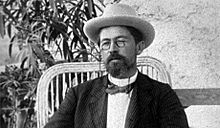 Folks rarely think about the dynamics that produce creative results. We may read a novel in a few hours but don’t ponder the years it took the author to research and craft their book. An audience likewise doesn’t think about the weeks of preparation it takes to produce the show they watch for 2 hours. We won’t examine the year Chekhov took to write Three Sisters, but instead take a peek at the process of mounting his play.
Folks rarely think about the dynamics that produce creative results. We may read a novel in a few hours but don’t ponder the years it took the author to research and craft their book. An audience likewise doesn’t think about the weeks of preparation it takes to produce the show they watch for 2 hours. We won’t examine the year Chekhov took to write Three Sisters, but instead take a peek at the process of mounting his play.
A theatrical production has body parts that include feet and legs. “Getting a play on its feet” refers to the rehearsal process and the show “gets its legs” after it opens. Other important body parts include hands, head and soul but this is a blog and not a primer on acting or an anatomy text. I’ll leave that to Mamet, Stanislavski and Dr. Grey.
Now back to the feet.
No surprise that there are 2 feet in the rehearsal process: training and blocking. Training includes table work, improv and exercise to help understand the text and build the character. Blocking is where the director moves the players to their actual positions on the stage. Both feet steadily keep walking (Yikes! Here come the analogy police!) toward opening night.
The rehearsal process gives the actor the opportunity to bond with fellow actors, create a deeper family connection, mine their character more thoroughly, And of course, get their actions and words deep into their bones so they appear natural and truthful.
Table Work
Table work explores what is on and off the page: the backstory, the actual lines, and what lies underneath or between the lines. (Chekhov was famous for “subtext” – the important stuff that isn’t actually spoken.)
Table work begins with a “read through” of the play from top to bottom so that the cast can hear it with the actual voices. As with every play I'm in, I get my script in advance and memorize my lines so I can participate in the first table read. (I use my talking computer which speaks the text aloud so I can memorize it. It’s also handy to run my sides against the machine as it reads my cue lines.) After the first read through, we start at the top of the script again and go line by line to clarify what is being said. It is during the table work that the actor gains understanding of context and intention.
Since “Three Sisters” takes place over the first few years at the turn of 20th century Russia, some understanding of Russian life at that time was needed. Fernando, our dramaturge (specialist in dramatic composition) gave us some insight into the essentially Russian feudal system prevalent during Chekhov's lifetime. Let’s see if I can give it to you in one sentence: If you were a fellow and owned land you were at the top of the food chain and could vote in the local government, one moved up in Russian society via military or heredity, and a woman’s career goal was to marry — hopefully a military bigwig.
The “backstory” is the family history that leads up to the first words spoken in the play. We uncovered the ages of the characters (Ferapont, my character, is 80) and explored the family events from 1880 to 1901, when the play begins. Daddy Prozorov, having moved his family, 11 years earlier, to a small provincial town from urban Moscow, dies one year before the first lines are spoken. His daughters, the three sisters, Olga, Masha and Irina, muse about returning to Moscow throughout the show.
I’ve included a few sample pictures of some of the actors (not in costume) portraying some of the characters in the backstory. (This was an exercise to flesh out some of the family history and is not indicative of the aesthetic of the production.)
My next post will eyeball some of the exercises and improvs we do to help tease out the useful stuff which informs and builds our characters, even as our feet keep on truckin’.
Stay tuned.



